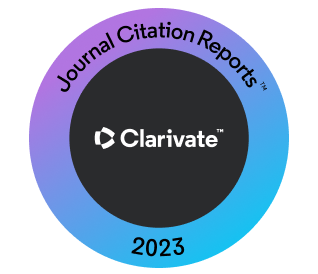A Hybrid of Artificial Bee Colony, Genetic Algorithm, and Neural Network for Diabetic Mellitus Diagnosing
Abstract
Researchers widely have introduced the Artificial Bee Colony (ABC) as an optimization algorithm to deal with classification and prediction problems. ABC has been combined with different Artificial Intelligent (AI) techniques to obtain optimum performance indicators. This work introduces a hybrid of ABC, Genetic Algorithm (GA), and Back Propagation Neural Network (BPNN) in the application of classifying, and diagnosing Diabetic Mellitus (DM). The optimized algorithm is combined with a mutation technique of Genetic Algorithm (GA) to obtain the optimum set of training weights for a BPNN. The idea is to prove that weights’ initial index in their initialized set has an impact on the performance rate. Experiments are conducted in three different cases; standard BPNN alone, BPNN trained with ABC, and BPNN trained with the mutation based ABC. The work tests all three cases of optimization on two different datasets (Primary dataset, and Secondary dataset) of diabetic mellitus (DM). The primary dataset is built by this work through collecting 31 features of 501 DM patients in local hospitals. The secondary dataset is the Pima dataset. Results show that the BPNN trained with the mutation based ABC can produce better local solutions than the standard BPNN and BPNN trained in combination with ABC.
Downloads
References
Akay, B. and Karaboga, D., 2015. A survey on the applications of artificial bee colony in signal, image, and video processing. Signal, Image and Video Processing, 9(4), pp. 967-990.
American Diabetes Association., 2014. Diagnosis and classification of diabetes mellitus. Diabetes Care, 37(Supplement 1), pp. S81-S90.
Atakulreka, A. and Sutivong, D., 2007. Avoiding local minima in feedforward neural networks by simultaneous learning, in AI 2007, Advances in Artificial Intelligence, Springer. Berlin Heidelberg, pp. 100-109.
Dai, Q. and Liu, N., 2012. Alleviating the problem of local minima in
Backpropagation through competitive learning, Neurocomputing, 94, pp. 152-158.
Gen, M. and Cheng, R., 1997. Genetic Algorithms and Engineering Design, John Wiley & Sons, New York.
International Diabetes Federation., 2014. IDF Diabetes Atlas, IDF. International Diabetes Federation. Available from: http://diabetesatlas.org/resources/2017-atlas.html. [Last retrieved on 2014 Nov 29].
Javadi, M.R., Mazlumi, K. and. Jalilvand, A., 2011. Application of GA, PSO and ABC in optimal design of a stand-alone hybrid system for north-west of Iran, in Electrical and Electronics Engineering (ELECO), 2011 7th International Conference on, pp. I-203-I-210.
Karaboga, D., Gorkemli, B., Ozturk, C. and Karaboga, N., 2014. A comprehensive survey: Artificial bee colony (ABC) algorithms and applications. Artificial Intelligence Review, 42(1), pp. 21-57.
Kohavi, R., 1995. A Study of Cross-Validation and Bootstrap for Accuracy
Estimation and Model Selection. Proceedings of the Fourteenth International Joint Conference on Artificial Intelligence. Vol. 2. Morgan Kaufmann, San Mateo, CA, pp. 1137-1143.
Kumar, R. and Verma, R., 2012. Classification rule discovery for diabetes patients by using genetic programming. International Journal of Soft Computing and Engineering, 2(4), pp. 183-185.
Nawi, N.M., Ghazali, R. and Salleh, M.N.M., 2010. The development of
improved back-propagation neural networks algorithm for predicting patients
with heart disease. In: Information Computing and Applications, Springer, Berlin. pp. 317-324.
Nawi, N.M., Ghazali, R. and Salleh, M.N.M., 2011. Predicting patients with heart disease by using an improved back-propagation algorithm, Journal of Computing, 3(2), pp. 53-58.
Nawi, N.M., Rehman, M.Z. and Khan, A., 2014. A new bat based backpropagation (BAT-BP) algorithm, In: Advances in Systems Science, Springer, Berlin. pp. 395-404.
Ojha, V.K., Abraham, A. and Snášel, V. 2017. Metaheuristic design of
feedforward neural networks: A review of two decades of research, Engineering Applications of Artificial Intelligence, 60, pp. 97-116.
Ojha, V.K., Dutta, P., Chaudhuri, A. and Saha, H. 2016. Convergence Analysis of Backpropagation Algorithm for Designing an Intelligent System for Sensing Manhole Gases. In: Hybrid Soft Computing Approaches, Springer, Berlin, pp. 215-236.
Priddy, K.L., and Keller, P.E., 2005. Artificial Neural Networks: An introduction. SPIE Press, Bellingham.
Rashid, T.A., Abdullah, S.M., and Abdullah, R.M., 2016. An Intelligent Approach for Diabetes Classification, Prediction and Description, In: Snášel, V., Abraham, A., Krömer, P., Pant, M., Muda, A., editors. Innovations in Bio-Inspired Computing and Applications. Advances in Intelligent Systems and Computing, Vol. 424. Springer, Cham.
UCI. 2015. Pima India Dataset. UCI Machine Learning Repository. Available from: https://www.archive.ics.uci.edu/ml/datasets/Pima+Indians+Diabetes.
Wild, S., Roglic, G., Green, A., Sicree, R., King, H. 2004. Global prevalence of diabetes estimates for the year 2000 and projections for 2030. Diabetes Care, 27(5), pp. 1047-1053.
Copyright (c) 2018 Tarik A. Rashid, Saman M. Abdullah

This work is licensed under a Creative Commons Attribution-NonCommercial-ShareAlike 4.0 International License.
Authors who choose to publish their work with Aro agree to the following terms:
-
Authors retain the copyright to their work and grant the journal the right of first publication. The work is simultaneously licensed under a Creative Commons Attribution License [CC BY-NC-SA 4.0]. This license allows others to share the work with an acknowledgement of the work's authorship and initial publication in this journal.
-
Authors have the freedom to enter into separate agreements for the non-exclusive distribution of the journal's published version of the work. This includes options such as posting it to an institutional repository or publishing it in a book, as long as proper acknowledgement is given to its initial publication in this journal.
-
Authors are encouraged to share and post their work online, including in institutional repositories or on their personal websites, both prior to and during the submission process. This practice can lead to productive exchanges and increase the visibility and citation of the published work.
By agreeing to these terms, authors acknowledge the importance of open access and the benefits it brings to the scholarly community.














 ARO Journal: A Scientific Periodical Open Access Journal and has no APC & ASC.
ARO Journal: A Scientific Periodical Open Access Journal and has no APC & ASC.